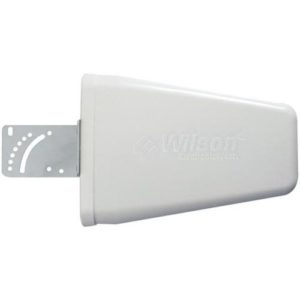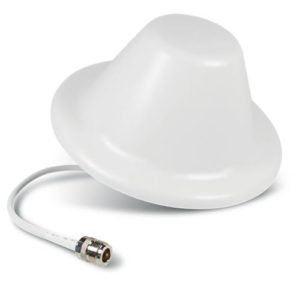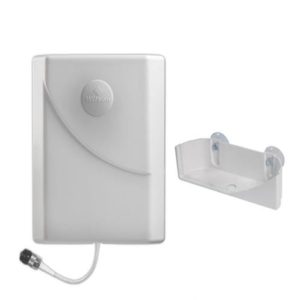Have you ever taken a good look at cell booster antennas? I realize this isn’t something that might cross your mind on the average day. (Between work, bills, and kids, we have enough to worry about.) If you have taken a peak at cell booster antennas – both indoor and outdoor – you’ve probably seen a variety of different antenna types. Some are flat while others might look like wedges, for example. What’s up with that? If you’ve ever wondered about these things, Solid Signal has the answers you seek. As your cell phone signal booster expert, we’re happy to share this crash course in cell booster antennas.
Indoor and Outdoor Cell Booster Antennas…
… When we’re talking about cell booster antennas, there are four types you need to know about. Those are log-periodic (also called LPDA), yagi, omni-directional, and panel antennas. We’ll define each of these types below; but for now, here are two very important things you need to know about these antenna types:
-
Outdoor cell booster antennas tend to be omni-directional, monopole, log-periodic, or yagi antennas.
-
Indoor antennas are usually omni-directional or panel antennas.
The antenna combination that you have or need will have to do with what type of installation you have. For example, an antenna combination that’s ideal for a home booster installation will be different than what you need for a business or commercial space. You’ll see why as you continue to learn more about the different types of cell booster antennas.
Log-Periodic Antennas for Cell Boosters

You can always tell a log-periodic antenna by its overall shape. These antennas have a wedge or triangular shape that’s wider at the bottom and narrower at the other end. While some log-periodic cell booster antennas are covered in a plastic radome, even those take on that characteristic wedge-like shape. The antenna’s reception beam emits from its tip in roughly 40 to 80 degrees wide, depending on make and model.
Like other cellular antennas, some log-periodic antennas receive frequencies in a very wide range, from 600-2200MHz. These antennas tend to have a more distinct wedge shape when they receive a very wide range of frequencies. Not all log-periodic antennas receive all frequencies, but all antennas that do receive the full range of cellular frequencies are called “wideband” antennas.
Yagi Cell Booster Antennas

You’re probably familiar with Yagi antennas. They were very common in the old days of antennas when people still called them “aerials.” When it comes to long-range reception, these antennas are still the most effective. They are also used as cell booster antennas. Yagi or Yagi-Uda antennas are named after their developers, Shintaro Uda and Hidetsugu Yagi. These devices are directional and have a reception beam similar to those of log-periodic antennas.
Both antennas can have differently-sized elements, and both can have reflectors at the back. However, every element in a log-periodic antenna has some connection to the cable, while yagi antennas have elements that aren’t connected. In many cases, an antenna can have characteristics of both a log-periodic and yagi antenna. True yagi antennas are limited to a single range of broadcast frequencies and are used for public safety systems and similar installations. The average homeowner won’t mount a yagi cell booster antenna to their home.
Omni-Directional Indoor Cell Booster Antennas

Let’s switch gears to talk about indoor cell booster antennas. The first one is the omni-directional or omni antenna. These devices have a 360 degree-wide horizontal transmission beam, which delivers improved cellular reception in all directions from the antenna’s center. This is why these devices are well-suited for indoor use because it allows the cell boosters to serve multiple devices within the coverage area. They work well in homes and other buildings with low ceilings, and drywall or wood walls/partitions.
So, what do omni-directional cell booster antennas look like. Well, these devices can take a variety of shapes. For example, some omni antennas are horizontal whip antennas used in two-way radios. Others are circular, such as the UFO-shaped TV antenna. When used as cell booster antennas, these devices are typically small domes covered in a plastic shell, aka the aka a radome.
Panel Antennas for Cell Phone Boosters

You’ll recognize a panel antenna the moment you see one. These devices are typically flat squares, just as the name suggests. Panel antennas are commonly used as the indoor antenna for a cellular phone boosters. Note: These antennas also can be used outdoors, typically in ultra-high frequency (UHF) capacities as base station antennas and other wireless networking installations.
Generally speaking, panel antennas are best used in installations that places callers next to or within the line of sight of the antenna. You’ll typically find these in businesses that have specific areas that need improved reception and quick data speeds, such as offices and conference rooms. The average panel antenna installation typically doesn’t waste signal on areas it’s not really needed, such as storerooms, restrooms, and closets.
Upgrading Your System’s Antennas
Every cellular signal booster system you purchase from Solid Signal comes with both an outdoor and indoor antenna. In many cases, there are kits where you can choose the right antenna for your needs. So why would you upgrade the antenna? Perhaps you are looking for more performance. Perhaps you didn’t realize how far away the towers actually are. Or, perhaps the cell booster doesn’t work as well because of metal studs or wiring in the walls. All of these are good reasons to upgrade your cell booster antenna.
“Which Cell Booster Antennas are Right for Me?”
We get this question a lot here at Solid Signal. Fortunately, we have the answer and it’s usually different for anyone who asks. What our cell phone booster experts usually say is, “That depends on what type of installation that you have.” Think about it. A home with 1,500 square feet of space has different coverage needs than a huge warehouse, for example.
It’s also important to consider the impedance of the antenna. Boosters for home and small office use often use 75-ohm antennas with the same “F” connector that your satellite TV cable uses. Commercial booster antennas use 50-ohm antennas with an “N” connector. Conventional wisdom says that the 50-ohm antenna can have longer cable runs than the 75-ohm antenna. This is true, but if you have a 75-Ohm system, you’ll actually lose a significant amount of range by choosing a 50-ohm antenna. Choosing the right impedance is just as important as choosing the right type of antenna!
No matter what you’re working with, Solid Signal is your source for custom cellular signal booster and antenna recommendations. We can help you and it all starts with a simple phone call. When you contact our team, they’ll ask you a few questions to help them determine what is the best cellular signal booster system for your needs. To get the process started, call 888-233-7563.

